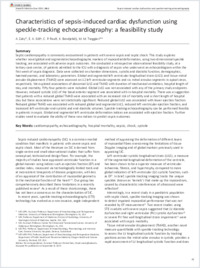Characteristics of sepsis-induced cardiac dysfunction using speckle-tracking echocardiography: a feasibility study.
- Zaky A Department of Anesthesiology and Perioperative Medicine, University of Alabama at Birmingham, Birmingham, AL, USA.
- Gill EA Department of Medicine, Division of Cardiology, University of Washington School of Medicine, Seattle, WA, USA.
- Lin CP Center for Clinical and Translational Science, University of Alabama at Birmingham, Birmingham, AL, USA.
- Paul CP Department of Anaesthesiology, Pharmacology and Intensive Care, Geneva University Hospitals, Geneva, Switzerland.
- Bendjelid K Department of Anesthesiology and Perioperative Medicine, Department of Public Health and Preventive Medicine, Oregon Health and Science University, Portland, OR, USA.
- Treggiari MM
- 2015-12-18
Published in:
- Anaesthesia and intensive care. - 2016
cardiomyopathy
echocardiography
hospital mortality
sepsis
shock
systole
Adult
Aged
Echocardiography
Feasibility Studies
Female
Heart Diseases
Humans
Male
Middle Aged
Mitral Valve
Retrospective Studies
Sepsis
Stroke Volume
Ventricular Function, Left
English
Septic cardiomyopathy is commonly encountered in patients with severe sepsis and septic shock. This study explores whether novel global and segmental echocardiographic markers of myocardial deformation, using two-dimensional speckle tracking, are associated with adverse sepsis outcomes. We conducted a retrospective observational feasibility study, at a tertiary care centre, of patients admitted to the ICU with a diagnosis of sepsis who underwent an echocardiogram within the first week of sepsis diagnosis. Data were collected on chamber dimensions, systolic and diastolic function, demographics, haemodynamics, and laboratory parameters. Global and segmental left ventricular longitudinal strain (LVLS) and tissue mitral annular displacement (TMAD) were assessed on 12 left ventricular segments and six mitral annulus segments in apical views, respectively. We explored associations of abnormal LVLS and TMAD with duration of mechanical ventilation, hospital length of stay, and mortality. Fifty-four patients were included. Global LVLS was not associated with any of the primary study endpoints. However, reduced systolic LVLS of the basal anterior segment was associated with in-hospital mortality. There was a suggestion that patients with a reduced global TMAD were associated with an increased risk of mortality and a short length of hospital stay but these associations were not statistically significant. Reduced global LVLS was associated with lower ejection fraction. Reduced global TMAD was associated with reduced global and segmental LVLS, reduced left ventricular ejection fraction, and increased left ventricular end-systolic and end-diastolic volumes. Speckle-tracking echocardiography can be performed feasibly in patients in sepsis. Global and segmental left ventricular deformation indices are associated with ejection fraction. Further studies need to evaluate the ability of these new indices to predict sepsis outcomes.
- Language
-
- English
- Open access status
- bronze
- Identifiers
-
- DOI 10.1177/0310057X1604400111
- PMID 26673591
- Persistent URL
- https://folia.unifr.ch/global/documents/89983
Statistics
Document views: 12
File downloads:
- fulltext.pdf: 0
